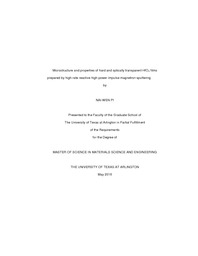
ATTENTION: The works hosted here are being migrated to a new repository that will consolidate resources, improve discoverability, and better show UTA's research impact on the global community. We will update authors as the migration progresses. Please see MavMatrix for more information.
Show simple item record
| dc.contributor.advisor | Meletis, Efstathios | |
| dc.creator | Pi, Nai-Wen | |
| dc.date.accessioned | 2016-07-08T20:29:34Z | |
| dc.date.available | 2016-07-08T20:29:34Z | |
| dc.date.created | 2016-05 | |
| dc.date.issued | 2016-05-13 | |
| dc.date.submitted | May 2016 | |
| dc.identifier.uri | http://hdl.handle.net/10106/25785 | |
| dc.description.abstract | Hafnium Dioxide (HfO2) has an extraordinary high bulk modulus, high hardness, high chemical stability, high melting point and high thermal stability. This material can be used as protective coatings for application involving high temperature environments. HfO2 films were fabricated on Si using high-rate reactive high-power impulse magnetron sputtering (HiPIMS) using different deposition-averaged target power density <Sd> and voltage pulse durations t1. Five HfO2 films were prepared with (1) t1 = 25 µs, <Sd> =7.6 Wcm-2 (T25S7), (2) t1 = 100 µs, <Sd> =7.2 Wcm-2 (T100S7), (3) t1 = 200 µs, <Sd> =7.3 Wcm-2 (T200S7), (4) t1 = 200 µs, <Sd> =18 Wcm-2 (T200S18) and (5) t1 = 200 µs, <Sd> =54 Wcm-2 (T200S54).
Atomic force microscopy (AFM) images of the T200S54, T200S18 and T200S7 films exhibit a coarser granular structure with a similar grain size varying from 25 nm to 120 nm in diameter and an average grain size of ~70 nm. AFM images of the T25S7 and T100S7 films show smaller granular structures compared to the other three films.
Transmission electron microscopy (TEM) studies show that all films are composed of an interlayer next to the Si interface followed by a nano-columnar structure layer. The interlayer structure of the films consists of a population of lower density nanoscale regions. A reduction in t1 and <Sd> in films T200S54, T200S18, T200S7 and T100S7 caused an increase in the interlayer thickness and a decrease in the width of the nano-columnar structures from ~46 nm to ~21 nm. This microstructural change was accompanied by a concomitant change of the grain boundary structure from tight and interlocking in films T200S54 and T200S18, to rough and thicker (~1 nm) boundaries in films T200S7 and T100S7. Film T25S7 exhibited an entirely different microstructure composed of a multilayered interlayer (~3 nm) and nano-columnar (~15 nm) structure. Films prepared with large t1 (200 µs) have a monoclinic HfO2 structure and that with small t1 (25 µs) an orthorhombic HfO2 structure. Film prepared with an intermediate t1 value (100 µs) exhibited a mixture of both monoclinic and orthorhombic phases. A high hardness of 17.6-17.0 GPa was shown for films with a monoclinic HfO2 structure. The films exhibited a refractive index of 2.02-2.11 and an extinction coefficient between ≤2x10-3 and 0.1x10-3 (both at a wavelength of 550 nm). High optical quality was achieved for films T200S54 and T200S18 owing to the presence of a dense microstructure with sharp and interlocking grain boundaries. | |
| dc.format.mimetype | application/pdf | |
| dc.language.iso | en_US | |
| dc.subject | Hafnium dioxide (HfO2) | |
| dc.subject | Hard coatings | |
| dc.subject | Pulsed magnetron sputtering | |
| dc.subject | High-resolution transmission electron microscopy | |
| dc.subject | Electron diffraction | |
| dc.title | Microstructure and properties of hard and optically transparent HfO2 films prepared by high-rate reactive high-power impulse magnetron sputtering | |
| dc.type | Thesis | |
| dc.degree.department | Materials Science and Engineering | |
| dc.degree.name | Master of Science in Materials Science and Engineering | |
| dc.date.updated | 2016-07-08T20:31:41Z | |
| thesis.degree.department | Materials Science and Engineering | |
| thesis.degree.grantor | The University of Texas at Arlington | |
| thesis.degree.level | Masters | |
| thesis.degree.name | Master of Science in Materials Science and Engineering | |
| dc.type.material | text | |
| dc.creator.orcid | 0000-0001-7057-7233 | |
Files in this item
- Name:
- PI-THESIS-2016.pdf
- Size:
- 3.574Mb
- Format:
- PDF
This item appears in the following Collection(s)
Show simple item record


